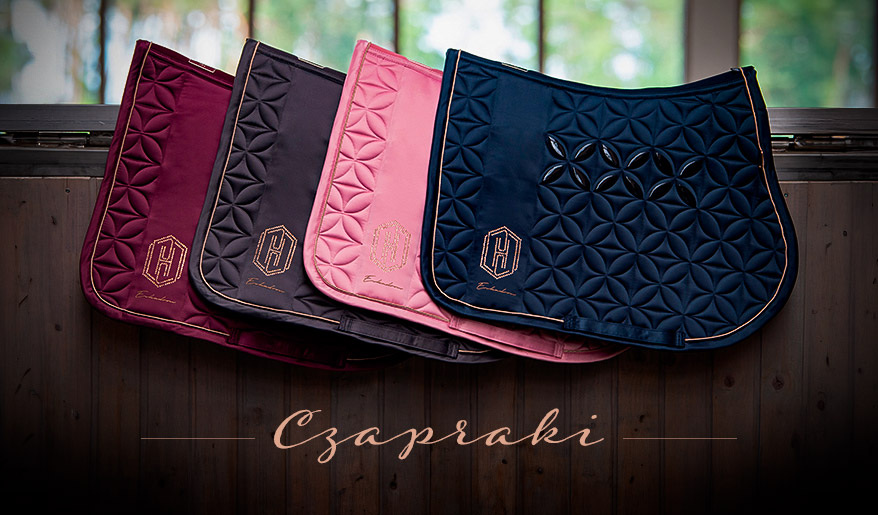Wędzidło to jeden z podstawowych elementów potrzebnych do jazdy konnej. Dopóki uczymy się jeździectwa w szkółce, pod okiem instruktora, nie zwracamy zbyt dużej uwagi na poszczególne detale. Jednak gdy nadchodzi moment, w którym sami kompletujemy sprzęt jeździecki dla swojego wierzchowca, okazuje się, że każdy element występuje w wielu odmianach. Wędzidło nie jest wyjątkiem. W tym tekście podpowiemy, jak wybrać odpowiednie wędzidło i jak działają poszczególne rodzaje.
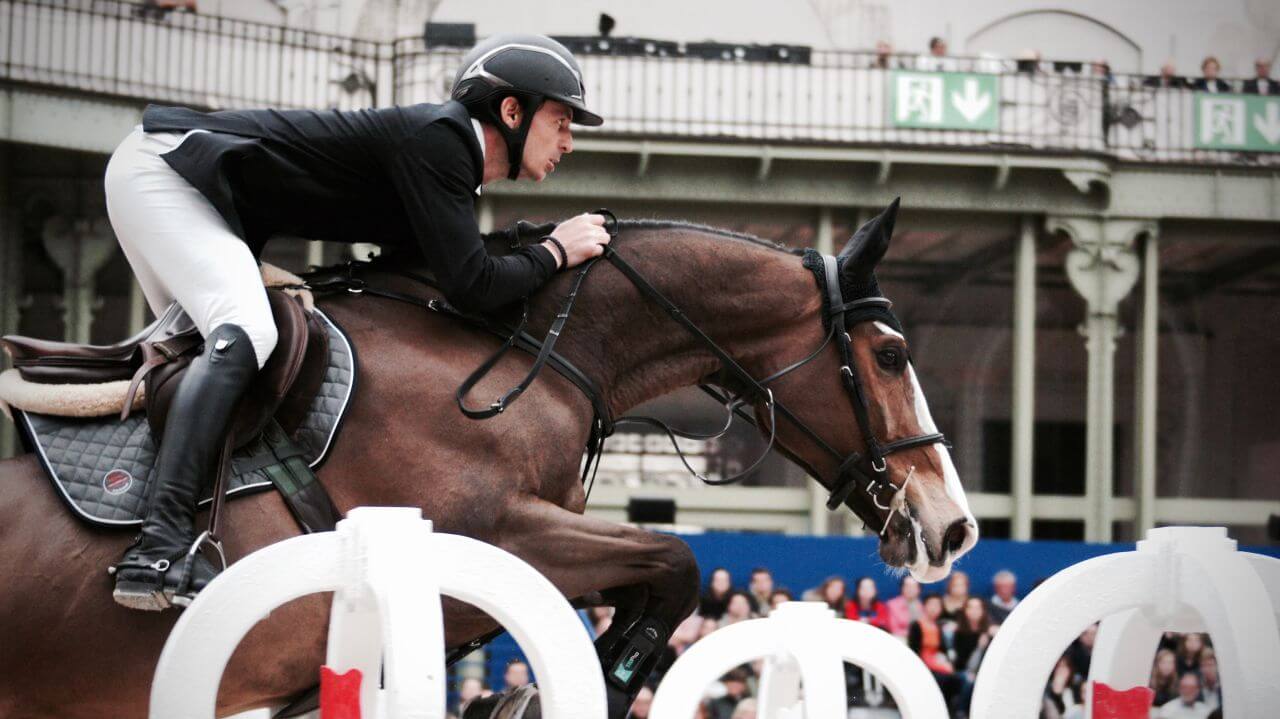
Każdy koń i jeździec mają w tej dziedzinie osobiste preferencje, z różnych powodów — u koni są one związane z budową szczęki, wrażliwością oraz odruchem przeżuwania przedmiotu znajdującego się w pysku. Z kolei jeźdźcy zwracają uwagę na komfortowy i precyzyjny kontakt z wierzchowcem oraz to, jak koń reaguje na dany rodzaj wędzidła. Często wybór jest podyktowany uprawianą dyscypliną sportową.
Z tego artykułu dowiesz się:
- Czym właściwie jest wędzidło i jak układa się w końskim pysku?
- Jakie są sygnały alarmowe, świadczące o złym dopasowaniu wędzidła?
- Co wziąć pod uwagę podczas wyboru wędzidła?
- Jakie są rodzaje wędzideł (podział ze względu na budowę pierścieni oraz elementu wewnątrz pyska konia, tzw. ścięgierza)?
- A dodatkowo poznasz nowość na rynku — świetne wędzidła Limo wykonywane z elastomerów termoplastycznych.
1. Wędzidło — czym jest i jak działa?
Wędzidło jest częścią ogłowia. Podczas jazdy znajduje się wewnątrz końskiego pyska i służy do precyzyjnego kontaktu z wierzchowcem oraz zachowania kontroli. Działa na cały obszar pyska: język, żuchwę, podniebienie i kąty pyska. Do pierścieni wędzidła (czyli elementów znajdujących się poza jamą ustną zwierzęcia) są przypięte wodze oraz paski policzkowe, które pomagają utrzymać ogłowie na właściwym miejscu.
W pysku konia jest wolna przestrzeń pomiędzy przednimi i tylnymi zębami. To w niej umieszcza się wędzidło. Dawniej było ono wykonywane z kawałka skóry, obecnie najczęściej spotyka się wędzidła metalowe lub z materiałów syntetycznych. Ten element ogłowia pozwala na wskazanie koniowi kierunku oraz zachowania kontroli.
Początkujący jeźdźcy często błędnie uznają wędzidło za podstawowy element komunikacji z koniem. Pamiętajmy, że wędzidło ma zapewnić bezpieczeństwo i bardziej precyzyjny kontakt. Podstawą porozumiewania się z wierzchowcem jest właściwy dosiad i łydki.
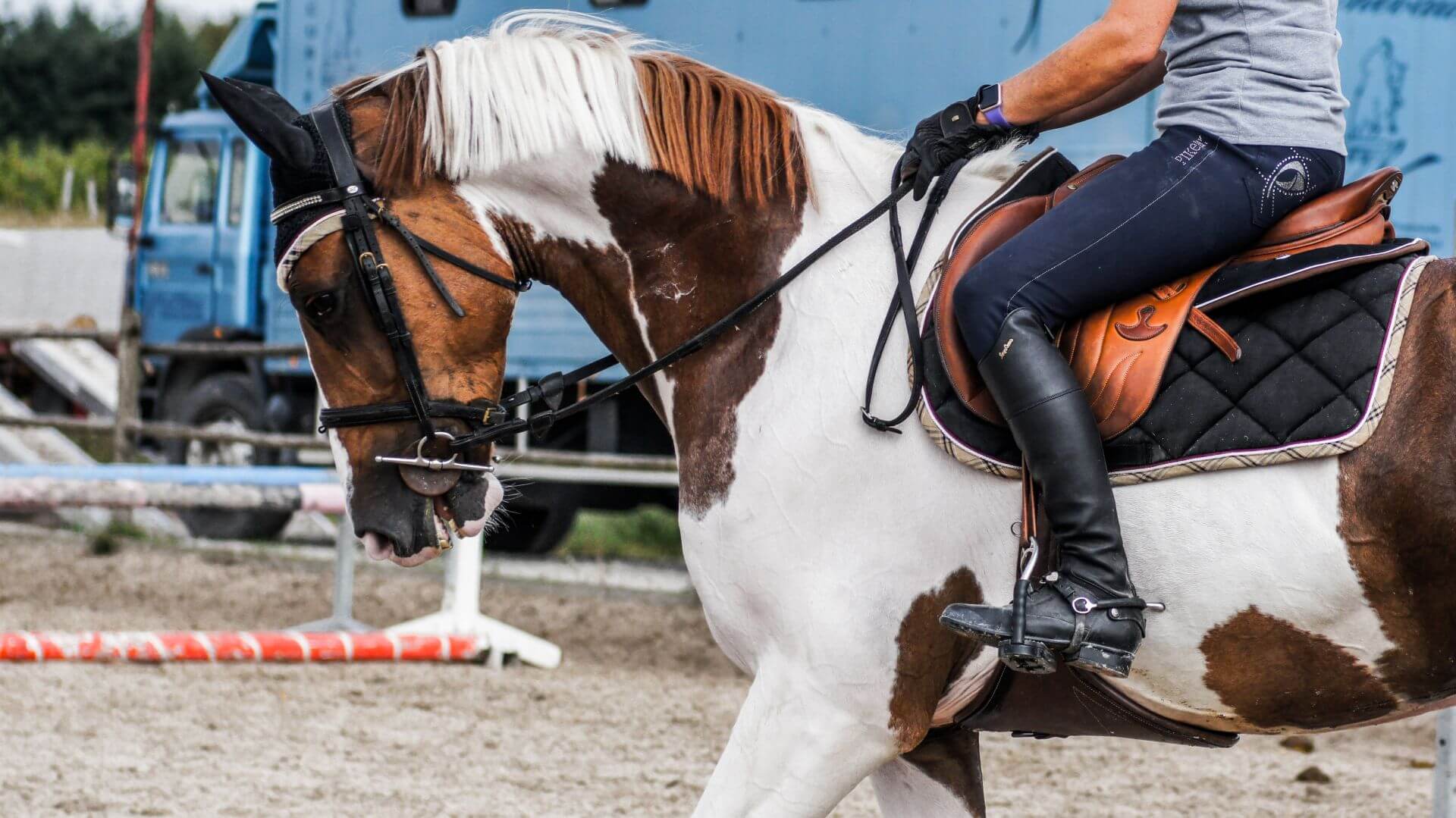
2. Sygnały alarmowe
Należy zwracać uwagę na sygnały alarmowe, które wskazują, że koń źle się czuje podczas użytkowania danego wędzidła. Są to m.in. nerwowe ruchy głową, próby gryzienia wędzidła, przekładanie języka nad wędzidło, otwieranie pyska, machanie ogonem, usztywnienie ciała. Wówczas należy wypróbować inne rodzaje wędzideł, bo przy takich oznakach trudno będzie prowadzić udany trening — to tak, jakby biegacz próbował pokonać kilkanaście kilometrów w niewygodnych butach.
Dużo jeźdźców, zwłaszcza tych początkujących ma obawy czy wędzidło boli konia. I tak i nie. Wędzidło to narzędzie, które w rękach osób niedoświadczonych może narobić dużo krzywdy koniowi i sprawić mu ból. Z drugiej jednak strony, nawet najmocniejsze wędzidła w rękach specjalistów są dla koni delikatnie i nie sprawiają im bólu. Co więcej, szkółki jeździeckie wybierają dla swoich koni bardzo delikatne wędzidła, które nawet nieświadomie nadużywane nie sprawią koniowi zbyt dużego bólu i dyskomfortu. Warto przyjąć zasadę, że im ostrzejsze wędzidło, tym bardziej doświadczony powinien być jeździec. Jeżeli nie masz doświadczenia w wyborze wędzidła, to najlepiej swój wybór skonsultuj ze swoim trenerem.
3.Co wziąć pod uwagę podczas wyboru wędzidła?
Wędzidła mogą różnić się materiałem, z którego zostały wykonane, kształtem pierścieni oraz budową części znajdującej się wewnątrz pyska konia. Różnią się też wielkością, którą należy dopasować do rozmiarów szczęki naszego wierzchowca.
Standardowe wielkości wędzideł to: 11,5 cm (kuce), 12,5 cm (hucuły, koniki polskie, konie czystej krwi arabskiej, niektóre konie małopolskie), 13,5 cm (większe konie wierzchowe, np. szlachetnej półkrwi, ras niemieckich czy konie wielkopolskie) 14,5 cm (konie zimnokrwiste i bardzo duże wierzchowce). Wędzidło powinno wystawać ok. pół centymetra z każdej strony końskiego pyska.
Wybór rozmiaru wędzidła to dość proste zadanie, bo jest on podyktowany łatwymi do sprawdzenia wymiarami. Nieco trudniej wybrać konkretny rodzaj wędzidła. Weźmy pod uwagę następujące czynniki:
- Czy mamy stabilną rękę, czy nie do końca?
- Czy nasz koń jest wrażliwy w pysku?
- Czy to młody koń, czy szukamy wędzidła dla sportowca?
- Czy mamy doświadczenie z określonym typem wędzidła i jak się ono sprawdzało?
- Jaki materiał preferujemy lub preferuje nasz koń (metal czy tworzywo sztuczne, a może wędzidło smakowe)?
- Z jakim przeznaczeniem wybieramy wędzidło (inne wybierzemy do szkółki, inne do ambitnej rekreacji na prywatnym koniu).
- Czy koń ma tendencje do gryzienia, przeciągania wędzidła lub przekładania języka?
- Czy szukamy łagodnego, czy ostrego wędzidła?
Odpowiedź na te pytania znacząco ułatwi nam zrozumienie, czego oczekujemy od naszego wędzidła. Warto przemyśleć ten zakup, bo ma nam służyć przez lata, a dodatkowo ma ogromny wpływ na naszą komunikację z koniem — zadbajmy, aby był to wpływ pozytywny.
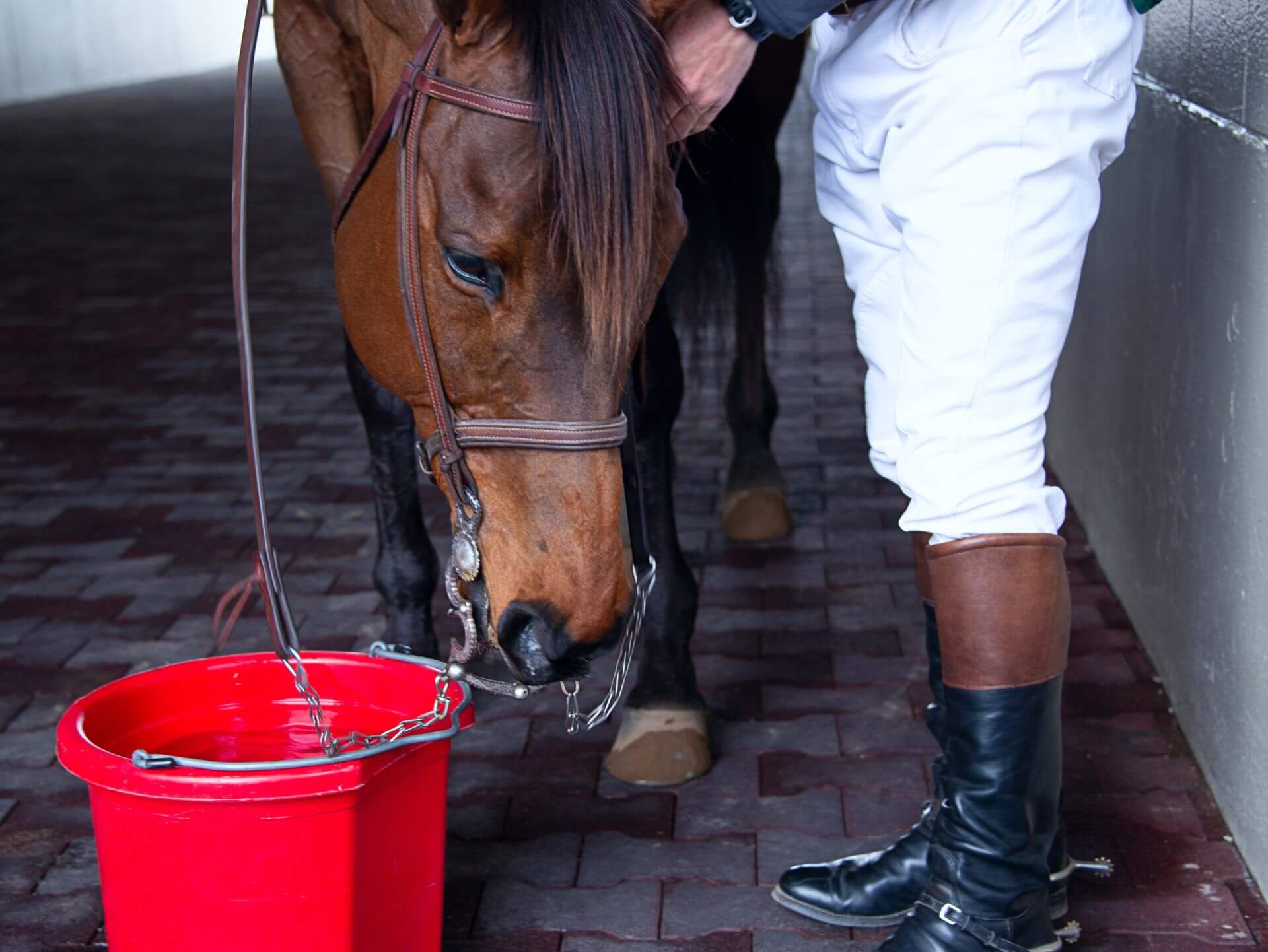
4. Rodzaje wędzideł — jakie są zastosowania poszczególnych typów?
Wędzidła różnią się budową pierścieni (elementów pozostających na zewnątrz pyska, do których przypinamy wodze) oraz konstrukcją ścięgierza, czyli elementu znajdującego się wewnątrz końskiego pyska. Warto wiedzieć, że grubość ścięgierza ma duże znaczenie: im cieńszy ścięgierz, tym wędzidło ostrzejsze. Z drugiej strony zbyt grube wędzidło zajmuje zbyt dużo miejsca i może być dla konia niewygodne, dlatego wskazana jest równowaga. Poniżej przedstawimy najpopularniejsze typy wędzideł.
Rodzaje wędzideł ze względu na budowę pierścieni
- Wędzidło z ruchomymi kołami (zwykłe)
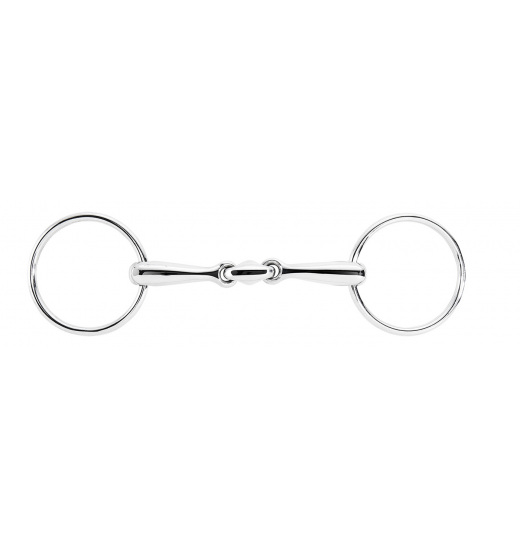
Pozwala na swobodne poruszanie się wędzidła w pysku konia. Dzięki temu koń chętniej przeżuwa wędzidło, co jest pozytywnym zjawiskiem.
Kup teraz wędzidło podwójnie łamane Edelstahl Ellipse
- Wędzidło oliwkowe

Jest dobrym wyborem dla jeźdźców o niestabilnej ręce. Dzięki temu, że pierścienie są nieruchome, nie podszczypują kącików pyska konia. To jedno z najdelikatniejszych wędzideł.
Kup teraz wędzidło oliwkowe Edelstahl
- Wędzidło z pierścieniami w kształcie litery „D”
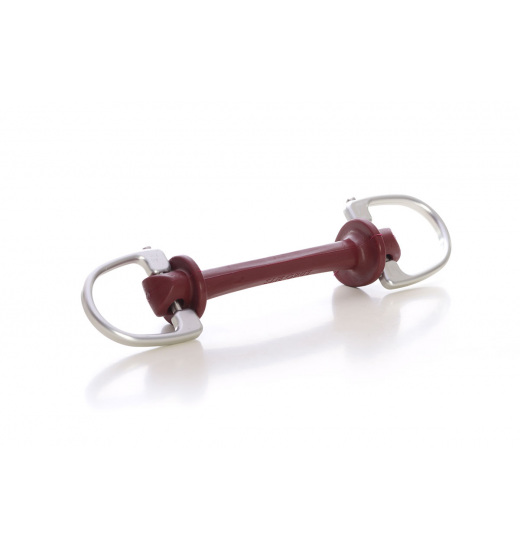
Tego typu pierścienie wywołują nieco mocniejszy nacisk na policzki, co ułatwia wykonywanie zakrętów. To dobry wybór dla wierzchowców o niewielkim doświadczeniu, a także tych, które próbują przeciągać wędzidło w pysku — kształt pierścieni im to uniemożliwia.
Kup teraz wędzidło D-Ring 65 Shore Miękkie
- Wędzidło z wąsami

Polecane dla młodych lub wyjątkowo silnych koni, a także wierzchowców, które próbują przeciągać wędzidło w pysku lub je gryźć. Dzięki naciskowi na policzki ułatwia wyjeżdżanie zakrętów, także krótkich i ostrych, dlatego jest chętnie używane w skokach przez przeszkody.
Kup teraz wędzidło z wąsami Edelstahl podwójnie łamane
- Wędzidło typu wielokrążek
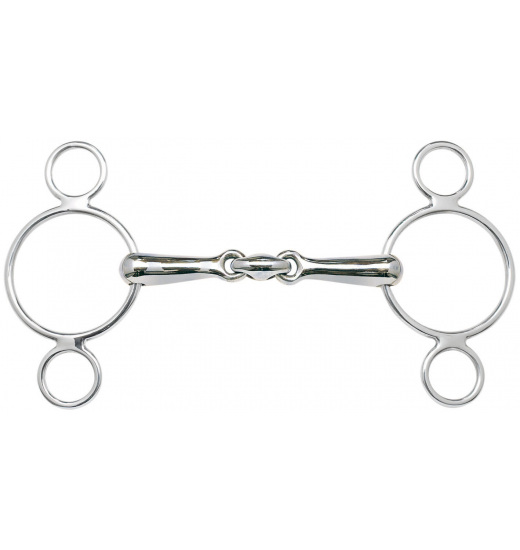
Jest cenione ze względu na swoją uniwersalność i możliwość przypięcia wodzy na różne sposoby. Można także spiąć wędzidło paskiem pod brodą konia, co poskutkuje bardziej bezpośrednim naciskiem na wędzidło, a także podpiąć dwie pary wodzy. Kółka umożliwiają działanie na zasadzie dźwigni. Ten typ jest chętnie wykorzystywany w crossie i w przypadku koni „do przodu”.
Kup teraz wielokrążek podwójnie łamany Edelstahl
- Wędzidło z czankami
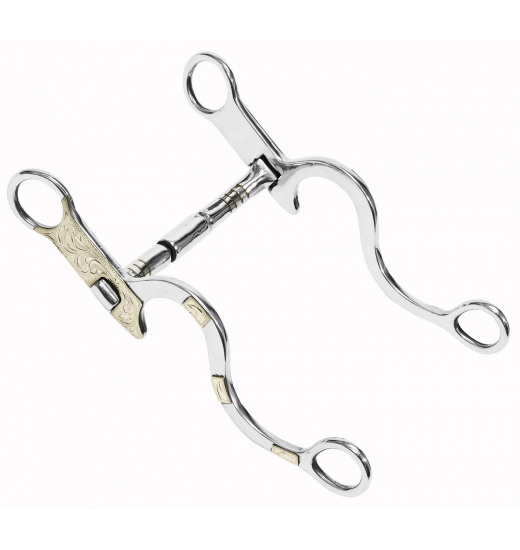
Tego typu wędzidło działa na zasadzie dźwigni. Im dłuższa czanka, tym działanie wędzidła ostrzejsze. Powinni go używać doświadczeni jeźdźcy z pewną ręką.
Kup teraz wędzidło z czankami Billy Allen Bit Show
- Munsztuk
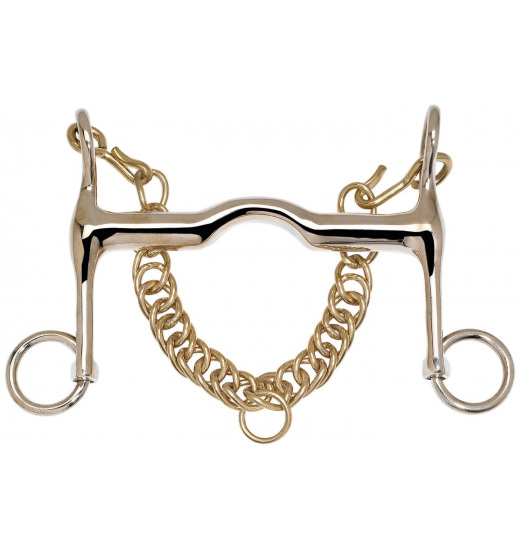
Munsztuk użytkuje się razem z wędzidłem munsztukowym. Wówczas koń ma w pysku dwa ścięgierze, a jeździec w rękach — dwie pary wodzy, którymi musi umieć operować jednocześnie. Wodze podpięte do dolnej części munsztuka działają na żuchwę. Nigdy nie jeździmy na samym munsztuku, ponieważ prosty ścięgierz i dźwignia tworzą silne kiełzno, które nie służy do powodowania (kierowania) koniem, a jedynie do wysyłania bardzo konkretnych sygnałów. W efekcie munsztuk jest tylko kiełznem dodatkowym. Najczęściej jest stosowany w dyscyplinie ujeżdżenia.
Kup teraz munsztuk Kaugan cienki
- Pelham
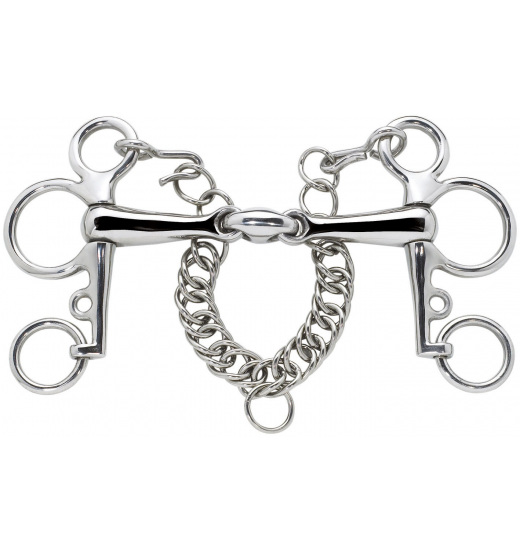
Wygląda jak połączenie munsztuka z wędzidłem. Dzięki temu, że wywiera nacisk na potylicę oraz żuchwę, ułatwia ustawienie szyi i głowy konia w takiej pozycji, jakiej oczekuje jeździec. Niekiedy stosuje się dwie pary wodzy (zwłaszcza w przypadku koni, które rzucają głową). Dolna para wodzy wywołuje silniejszy nacisk, który sprawia, że koń obniża głowę.
Kup teraz pelham Edelstahl podwójnie łamany
Uwaga! Ostatnie trzy wędzidła — czankowe, munsztuk i pelham — powinny być używane tylko przez osoby doświadczone lub pod okiem profesjonalisty. Absolutnie nie mogą służyć do „poskromienia” nieposłusznych koni. Silny nacisk takiego kiełzna wywołuje frustrację, ból, a w skrajnych przypadkach szarpnięcie za wodze może złamać koniowi szczękę. Pamiętajmy, że podstawą jest prawidłowy dosiad i praca z ziemi, a ostre kiełzna mają podkreślić efekty już uzyskanej pracy, nie stanowią drogi na skróty.
5. Rodzaje wędzideł ze względu na budowę elementu znajdującego się wewnątrz pyska (ścięgierza)
- Wędzidło proste
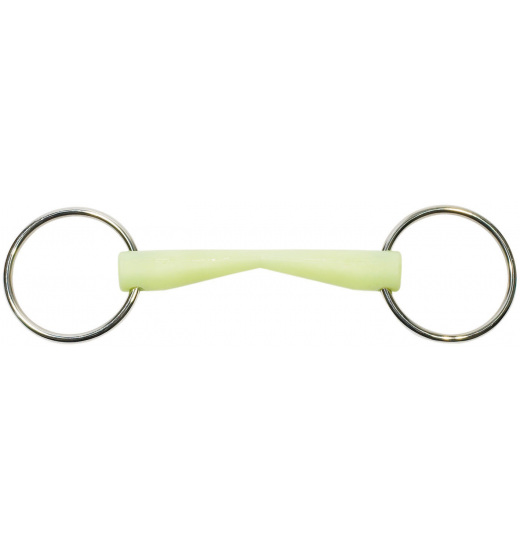
Uznawane za dość delikatne, zwłaszcza jeśli jest tak wyprofilowane, jak na zdjęciu (wersja komfort) — zapewnia odpowiednią przestrzeń dla języka i równomiernie rozkłada nacisk. Wówczas stanowi odpowiednie wędzidło dla młodych koni i jest przez nie chętnie przyjmowane. Należy uważać, by nie działać zbyt mocno jedną wodzą, bo wędzidło proste, zwłaszcza w podstawowej wersji, ma tendencję do przesuwania się w pysku.
Kup teraz wędzidło proste Double Flexi
-Wędzidło językowe
To bardzo dobre wędzidło dla koni, które przekładają język nad ścięgierz albo nie akceptują nacisku zwykłego wędzidła. Językowe jest wygięte w taki sposób, że pozostawia przestrzeń w pysku konia, dzięki czemu jest częściej akceptowane i chętnie żute przez wierzchowce.
- Wędzidło pojedynczo łamane
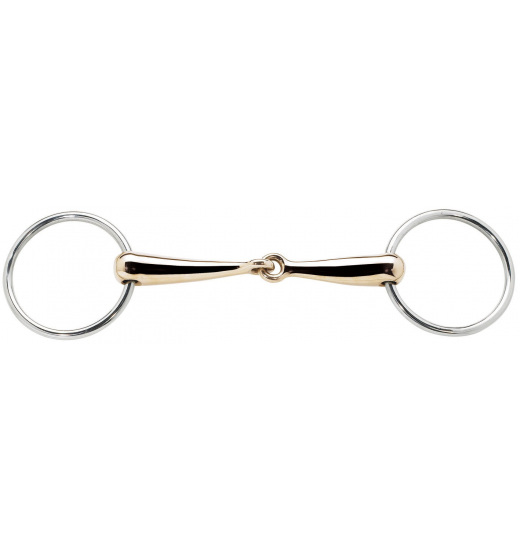
To bardzo popularny typ wędzidła, więc niektórych może zdziwić, że nieodpowiednio dopasowane lub źle użytkowane, to kiełzno jest dość ostre. Wywiera nacisk na język i dolną krawędź żuchwy. Jest dobre dla koni aktywnych w pysku oraz młodych wierzchowców, bo zapewnia odpowiednią kontrolę. Czasem jednak mogą działać na zasadzie „dziadka do orzechów” — załamywać się w środkowej części, co jest bolesne dla konia i zmusza go do otwierania pyska.
Kup teraz wędzidło łamane Kaugan masywne
- Wędzidło podwójnie łamane
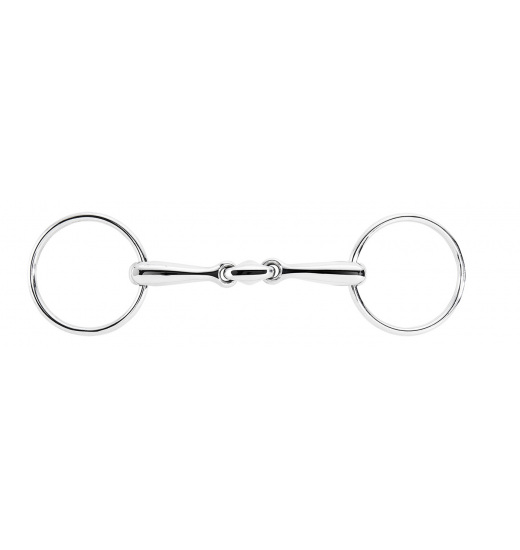
To wędzidło o delikatnym działaniu, które odpowiada większości wierzchowców. Dobrze dopasowuje się do pyska i może być używane u koni młodych oraz wrażliwych. Im krótszy łącznik pośrodku ścięgierza, tym działanie wędzidła jest mocniejsze.
Kup teraz wędzidło podwójnie łamane Edelstahl-Ellipse cienkie
- Wędzidło z zabawką
Wędzidło z ruchomym elementem przyczepionym do ścięgierza zachęca zwierzę do żucia oraz zapobiega przekładaniu języka. Czasem spotyka się też wędzidła z rolkami, które obracają się wokół osi ścięgierza, pobudzając wydzielanie śliny i zachęcając konia do lepszej pracy na wędzidle.
- Wędzidło anatomiczne
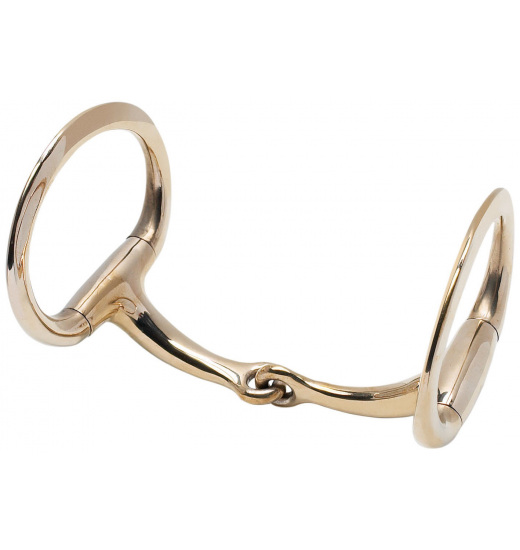
To nowoczesny typ wędzidła, który bardzo dobrze dopasowuje się do końskiego pyska. Delikatne wygięcie zapewnia wierzchowcowi duży komfort, co przekłada się na rozluźnienie konia podczas jazdy. Tego typu wędzidła mogą być pojedynczo lub podwójnie łamane, oliwkowe oraz z pierścieniami w kształcie litery „D”.
Nowoczesne wędzidła Limo — komfort i wysoka jakość
Kup teraz wędzidło oliwkowe Kaugan
W naszym sklepie jeździeckim Equishop od niedawna można kupić innowacyjne wędzidła Limo. Tę markę wyróżnia filozofia pełna harmonii i zrozumienia dla potrzeb koni. Ścięgierze wędzideł firma Limo wykonuje ze sztucznego materiału: elastomeru termoplastycznego. W przekroju mają one kształt sześciokąta. Elementy są tworzone w dwóch poziomach twardości (do wyboru) i mogą mieć zróżnicowaną budowę pierścieni. Wszystko po to, aby wędzidło było bezpieczne i komfortowe dla wierzchowca, niezwykle estetyczne oraz praktyczne w użyciu.
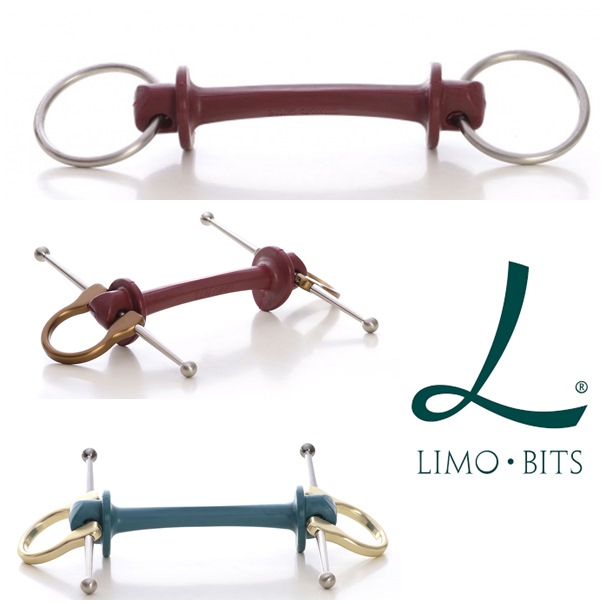
Wędzidła Limo zwracają uwagę szerokim wyborem rodzajów pierścieni, precyzją wykonania i bardzo dobrą jakością. Pozwalają na precyzyjny, ale subtelny kontakt z koniem oraz na realizowanie jeździeckich ambicji w sposób bezpieczny i wygodny dla wierzchowca. Marka Limo na swojej stronie przekonuje: “jeśli skupisz się bardziej na komforcie niż na wyniku, nie pomylisz się”. Te słowa zawsze warto mieć na uwadze podczas wyboru najlepszego wędzidła dla swojego konia.
Kliknij, aby zobaczyć ofertę wędzideł Limo Bits
Szukasz odpowiedniego wędzidła dla swojego konia? Sprawdź naszą szeroką ofertę wędzideł i innych akcesoriów dla konia: wędzidła, ogłowia, kantary.
Masz pytania? Zadźwoń lub napisz do nas.
Aktualności ze sklepu jeździeckiego Equishop:




















